How to Wire a Generator Transfer Switch (8 Step Walkthrough)
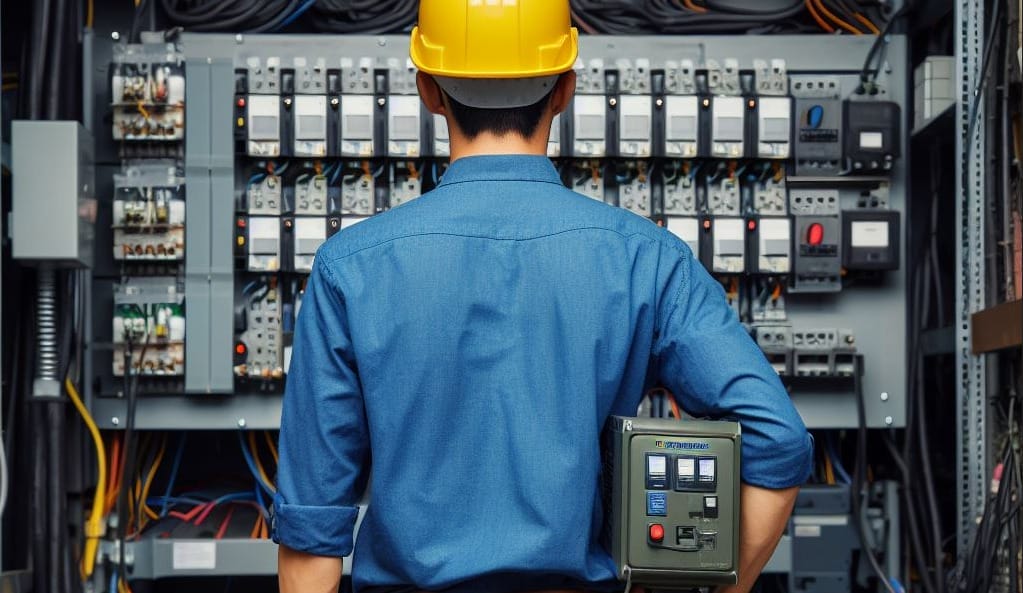
If you’ve wired a power generator to something essential, such as a well pump, you can install a transfer switch to handle a power loss situation conveniently.
The transfer switch switches the connection from your main electricity supply (utility) to the generator when there is no main power, automatically or manually. So, when the generator is on, you only have to turn on the attached load instead of disconnecting it from the main supply and then connecting it to the generator. Sounds convenient, but how do you wire a generator transfer switch?
To wire a generator transfer switch, connect the line wires from the generator to the top emergency power or R terminals on the transfer switch and the corresponding wires from the main supply to the top N terminals. Connect the load to the bottom terminals. The process can be fully automated using a relay switch, connecting the generator’s line wires to the NC and common terminals and those from the main supply to the main terminals for normal operation.
I’ll show you in more detail below with illustrations of how to wire a generator transfer switch to a circuit that controls an essential load.
Transfer Switches
Generator transfer switches come in two types: manual and automatic.
Both function to switch between the utility and backup generator power. A manual type must be switched over manually, whereas an automatic one seamlessly switches between the two power sources.
They come in various wattage, amperage ratings, and enclosures to suit the attached appliance. A light indicator tells you which power source is being used. Some automatic ones also have a manual override and digital load management technology to provide a more reliable backup and reduce downtime and costs.
Some manual transfer switches can be upgraded to automatic types. If you’re interested in this possibility, look for “upgradeable manual transfer switches’.
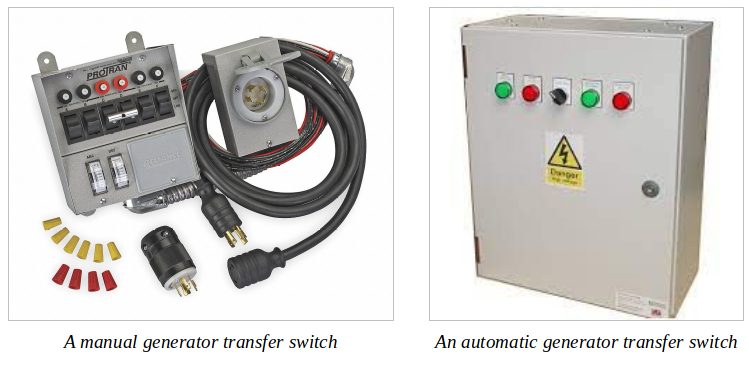
So, to be clear, we are going to wire a generator transfer switch that can (manually or automatically) switch between two power sources:
- The main electricity supply or utility power from the power grid
- The power generator is a source of electricity, usually for backup.
This makes having a transfer switch very convenient if you suffer from long and frequent power outages.
A Permanent Generator Connection
Before adding a transfer switch, you’ll also want to install a double-pole breaker at the generator’s subpanel to connect the attached load permanently. I showed how to do this for a well pump. You may click here.
I will briefly show how to install the transfer switch before we wire it. Remember to turn the main breaker OFF before working on your electrical system.
Installing a Transfer Switch
Here are the steps (8 in total) [Silver Cymbal]:
- Step 1: Attach a nail or screw to the transfer switch casing.
- Step 2: Mount the transfer switch casing.

- Step 3: Screw the casing to the wall securely.
- Step 4: Insert the transfer switch.
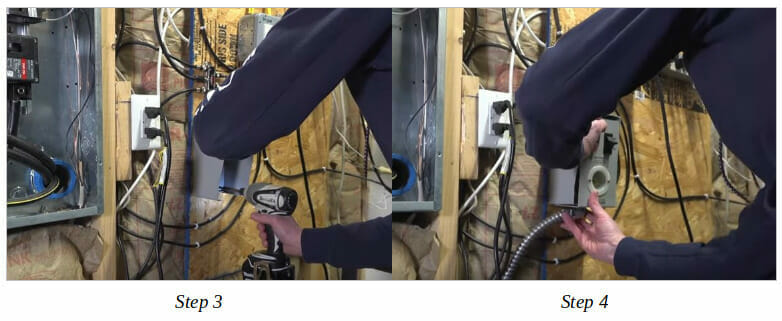
- Step 5: Secure the transfer switch to its casing.
- Step 6: Open a knockout on the panel and insert the transfer switch cable.
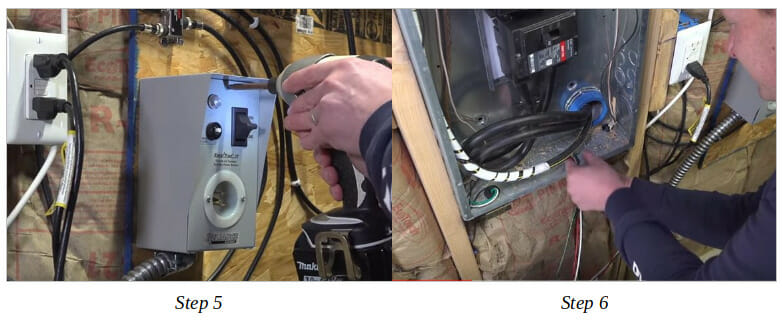
- Step 7: Attach the nut to secure the wire enclosure. Ensure it is tight.
- Step 8: You will have four wires to connect inside the panel (see the next section).
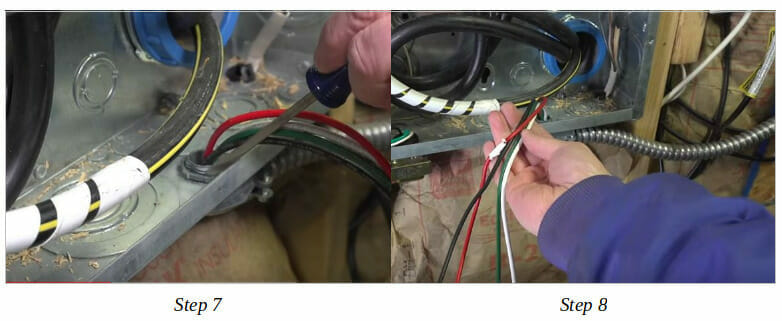
Wiring a Simple Generator Transfer Switch
Wiring Diagram
Here’s a simple wiring diagram for a typical (manual or automatic) generator transfer switch:
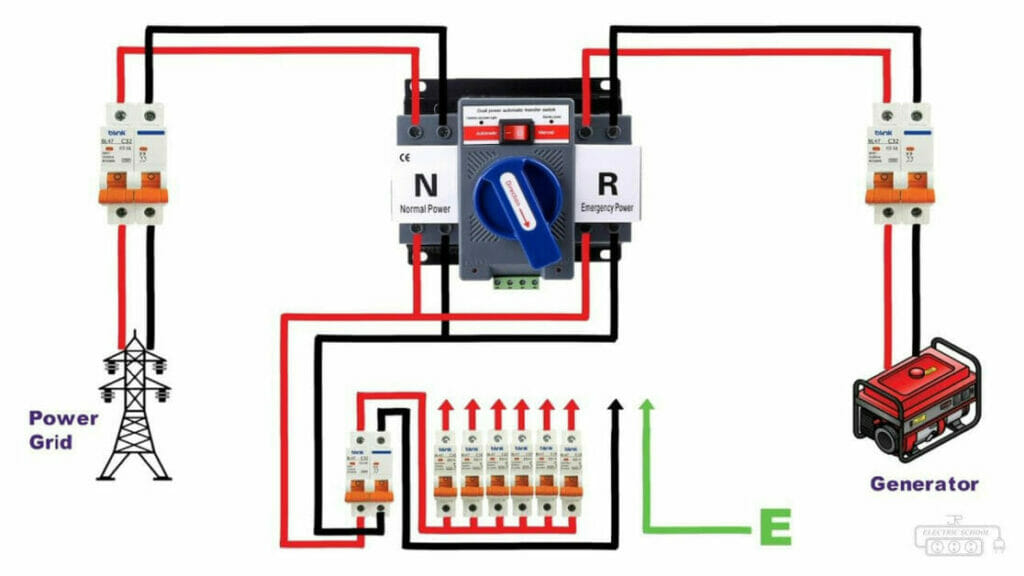
A closer look at the connections on the transfer switch:
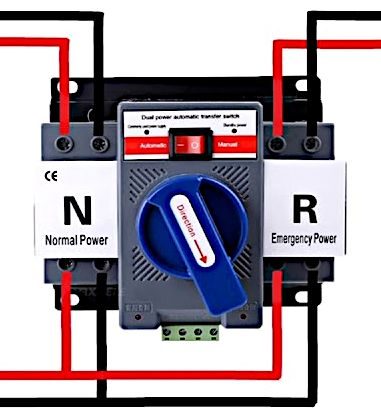
The above transfer switch has two parts marked N and R, with two terminals on the top and bottom. N stands for ‘normal power’, and R is for ‘emergency power.’
Wiring Procedure
Wire the transfer switch as follows:
- Attach wires from the bottom terminals of (both parts of) the transfer switch to the main circuit breaker, which controls the individual breakers of the load circuits.
- Attach the generator power supply cable wires (via a circuit breaker) to the top terminals of the transfer switch’s R (backup power) part.
- Attach the main or utility power supply cable wires (via a main breaker) to the two top terminals of the transfer switch’s N (main power) part.
Wiring a Fully Automatic Generator Transfer Switch
Wiring Diagram
A fully automatic generator transfer switch relies on a relay (the top right component in the diagram below) and an electric starting type generator.
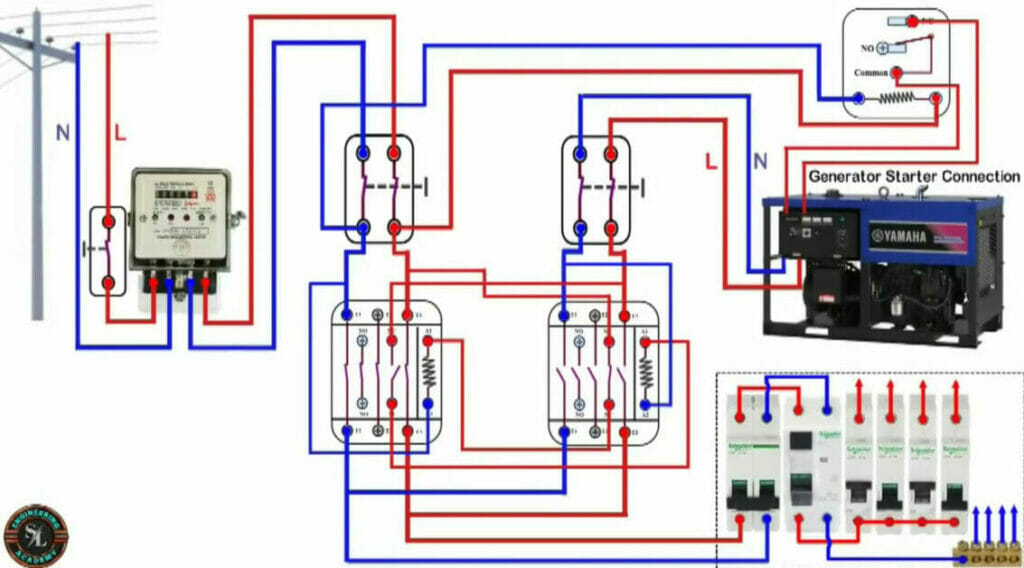
A closer look at the connections on the relay:
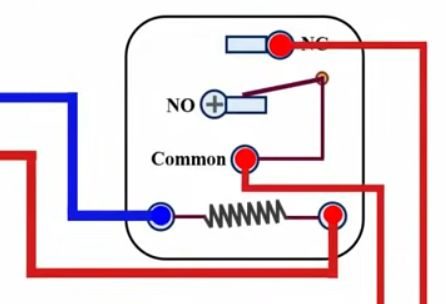
In its normal operational state, the main or utility power is on, and the generator is off.
When the utility power goes off, e.g., when there’s a power outage, the relay coil de-energizes, causing it to be in a ‘normally closed’ condition. This automatically starts the generator.
When the utility power is restored, the relay coil is energized again, so the relay acts in a ‘normally open’ condition. This automatically turns the generator off.
Wiring Procedure
Note the relay functions as the transfer switch, making it fully automatic. Wire the transfer switch as follows:
- Attach the hot wires from the generator to the NC (normally closed) and common points on the relay switch. They are the red live wires on the right-hand side in the above diagram of the relay.
- Attach the hot and neutral wires from the main power source (left-hand side) as shown above.
Manual Generators
Note that the generator in a fully automatic setup must be an electric starting type for full automation to be possible using a relay.
A generator that starts manually doesn’t need a relay circuit. Start the generator manually when the main power is off, and turn it off when it is restored.
Frequently Asked Questions (FAQs) – Transfer Switch Basics
Hey folks! I know things can get confusing when diving into generator transfer switches. So, let’s clear up some things and answer the most burning questions you all might have!
1. Manual vs. Automatic: What’s the difference?
Simple. Manual means you’ve got to do the switching yourself. Automatic? It does the work for you, flipping between power sources seamlessly. No sweat!
2. How do I know which power source is being used?
Many transfer switches have a light indicator. It’s like a little wink telling you which source runs the show.
3. Can I upgrade my manual switch to an automatic one?
Good news! Some manual switches can be upgraded to automatic. If that tickles your fancy, look for those “upgradeable manual transfer switches.”
4. What’s the first thing I should do before installing a transfer switch?
Safety first! Always, and I mean ALWAYS, turn off your main breaker. Electricity is no joke!
5. Why would I want a transfer switch?
If you’re tired of long and dragging power outages ruining your day, a transfer switch is your best buddy. It makes sure you’re not left in the dark, literally!
6. What’s this relay business in a fully automatic transfer switch?
The relay is the brains of the operation. When the main power goes out, it tells the generator to start. When power’s back, it says, “Good job, generator, you can rest now.”
7. What if my generator is a manual start? Do I need the fancy relay?
If you’re rocking a manual generator, skip the relay. You’ll start and stop your generator the old-fashioned way: with some elbow grease!
8. Where can I see these switches in action?
Check out the video references at the end of the article! It’s like having me there with you, guiding you through the steps.
9. How do I wire a simple generator transfer switch?
I’ve got a whole section on that! Follow the step-by-step guide in the article, and you’ll be a pro in no time.
I hope that clears things up! Now, make your power situation a whole lot smoother. And remember, always prioritize safety and call in the pros if you’re unsure. Cheers!
References
Website Resources:
- A manual and automatic generator transfer switch. https://www.grainger.com/product/RELIANCE-Manual-Transfer-Switch-125-2KEP3
- Manual transfer switch. https://www.grainger.com/product/RELIANCE-Manual-Transfer-Switch-125-2KEP3
Video References:
Valid Consumer
JR Electric School
Silver Cymbal
SL Engineering Academy
